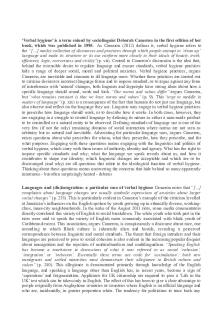Hygiene Case study answers PDF

| Title | Hygiene Case study answers |
|---|---|
| Course | Nursing I |
| Institution | Rowan College of South Jersey |
| Pages | 3 |
| File Size | 42.7 KB |
| File Type | |
| Total Downloads | 73 |
| Total Views | 151 |
Summary
Download Hygiene Case study answers PDF
Description
Suggested Answers to Case Studies, Chapter 31, Hygiene 1a. Appropriate questions/statements that would address your patient’s bathing habits include:
Please describe your bathing habits.
Are there special bathing or hygiene products you routinely use---or can’t use?
When is your favorite time to bath?
1b. Appropriate questions with which to address her deficient hygiene would include:
Is there anything (now, or in the past) that has interfered with your hygiene practices?
Does anything interfere with you being as clean as you’d like?
I see you use a walker, are you in need of any assistive devices like a shower chair?
1c. Questions regarding her skin condition are appropriate due to:
Her deficient hygiene
Her age
The fragility of her skin
1d. Deodorant soap would not be the best soap for her because it contains chemicals that will excessively dry her skin. In some cases, a soap substitute would be more helpful. 1e. The most appropriate bathing style(s) for her on the days where her aide doesn’t visit would include:
Sponge bath of perineal areas for freshening (bag bath could also be used)
Suggested Answers to Case Studies, Chapter 31, Hygiene
Warm water and washcloth for face and neck for refreshing
1f. Three appropriate hygienic goals for your patient would include:
Level of patient participation in hygienic program
Elimination of, reduction in, or compensation for factors that interfere with the patient’s hygienic success
Changes as related to patient-specific skin problems
2a. Hygienic issues of utmost importance to patients using an indwelling catheter would include:
Scrupulous, daily catheter care
Inspection of the urinary meatus
Notation of urine characteristics
Notation of painful or burning urination (on nonparaplegic patients)
2b. Other information that can be gleaned from a hygienic assessment includes:
Physical mobility limitations
Mental health alterations
The presence of skin lesions
The patient’s economic/housing status
2c. Aspects for which helping a patient with bathing promotes health include:
Cleanses the skin
Conditions the skin
Contributes to relaxation, especially of restless patient
Promotes circulation
Promotes range of motion
Suggested Answers to Case Studies, Chapter 31, Hygiene
Stimulates rate and depth of respirations
Promotes comfort
Provides sensory input
Helps to improve self-image
Provides opportunity for nurses to thoroughly assess patient integument
Promotes nurse--patient bond
2d. Introducing this patient to a bag bath could be extremely helpful. Using a bag bath would enable the patient to have a warm/hot sponge bath whenever desired, and would promote skin integrity and reduce potential infection issues with his indwelling catheter. 2e. Appropriate nursing interventions for the spot on this patient’s left buttock would include:
Positioning to decrease the pressure on the area
Frequent skin cleansing and care (lotion, air, and the like) to increase circulation
Notifying the health care provider of the spot’s characteristics
Encouraging scrupulous perineal care...
Similar Free PDFs

Hygiene Case study answers
- 3 Pages

Case Study with answers
- 6 Pages

Depression case Study Answers
- 2 Pages

Case study - answers
- 1 Pages

Kate Spade Case Study Answers
- 17 Pages

Answers to Case Study 1
- 3 Pages

Module 3 Case Study Answers
- 6 Pages

Verbal hygiene
- 2 Pages
Popular Institutions
- Tinajero National High School - Annex
- Politeknik Caltex Riau
- Yokohama City University
- SGT University
- University of Al-Qadisiyah
- Divine Word College of Vigan
- Techniek College Rotterdam
- Universidade de Santiago
- Universiti Teknologi MARA Cawangan Johor Kampus Pasir Gudang
- Poltekkes Kemenkes Yogyakarta
- Baguio City National High School
- Colegio san marcos
- preparatoria uno
- Centro de Bachillerato Tecnológico Industrial y de Servicios No. 107
- Dalian Maritime University
- Quang Trung Secondary School
- Colegio Tecnológico en Informática
- Corporación Regional de Educación Superior
- Grupo CEDVA
- Dar Al Uloom University
- Centro de Estudios Preuniversitarios de la Universidad Nacional de Ingeniería
- 上智大学
- Aakash International School, Nuna Majara
- San Felipe Neri Catholic School
- Kang Chiao International School - New Taipei City
- Misamis Occidental National High School
- Institución Educativa Escuela Normal Juan Ladrilleros
- Kolehiyo ng Pantukan
- Batanes State College
- Instituto Continental
- Sekolah Menengah Kejuruan Kesehatan Kaltara (Tarakan)
- Colegio de La Inmaculada Concepcion - Cebu







